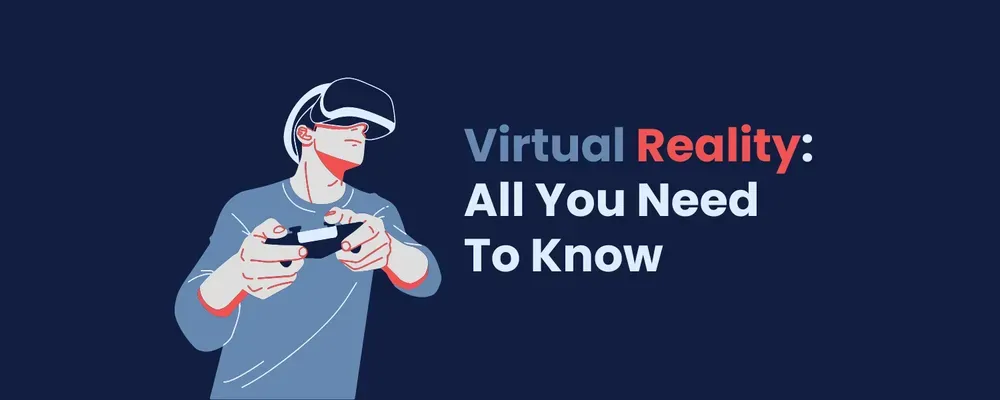Virtual Reality: All You Need To Know

Virtual reality (VR) is a technology that immerses users in a computer-generated simulated environment. It has come a long way since its origins in the 1960s and has been used in a variety of industries, from gaming to healthcare. In this article, we will explore the history of VR, how it is currently being used, and the potential for its future use in business, corporate life, gaming, lifestyle, and home. We will also examine the ways in which VR is being used in marketing, and how it may evolve in the near future. Finally, we will make some predictions about the future of VR.
The Origins of VR
The concept of virtual reality can be traced back to the 1960s, when computer scientist Ivan Sutherland developed the first head-mounted display (HMD) as part of his PhD thesis at the University of Utah. The HMD was known as the "Sword of Damocles," and it was a cumbersome device that was suspended from the ceiling. Despite its limitations, the Sword of Damocles was the first step towards the development of VR as we know it today.
In the 1970s, computer scientist Myron Krueger developed a system called "Artificial Reality," which used a combination of video cameras and computer graphics to create interactive environments that users could explore. Krueger's system was the first to use the term "virtual reality," and it laid the foundation for the development of VR as a medium for entertainment and education.
In the 1980s, companies such as VPL Research, founded by Jaron Lanier, began to develop and sell VR hardware and software. The first VR HMDs were sold to the military for training simulations, but the technology quickly found its way into the entertainment industry. In 1991, the first VR arcade game, "Dactyl Nightmare," was released, and it was followed by a number of other VR-based games and experiences.
Current Use of VR
Today, VR is used in a wide range of industries and applications, from gaming to healthcare. One of the most popular uses of VR is in gaming, where players can immerse themselves in interactive worlds and experience a level of realism that is not possible with traditional gaming. VR is also used in the entertainment industry, where it is used to create virtual theme parks and other immersive experiences.
In healthcare, VR is used to treat a variety of conditions, such as post-traumatic stress disorder (PTSD) and phobias. VR therapy allows patients to confront their fears in a safe and controlled environment, which can be more effective than traditional therapy methods.
VR is also being used in education, where it is used to create interactive and engaging learning experiences. In the business world, VR is used for training simulations and to create virtual meeting spaces.
Big Software and Hardware Players
There are a number of companies that are leading the way in the development of VR hardware and software. Some of the biggest players in the VR market include:
- Meta: Since Meta is going all in on Horizon Worlds, their take on the metaverse, they acquired Oculus a few years ago and transformed it to Meta Quest to provide users with a seamless and natural way to interact with Horizon Worlds.
- HTC: HTC is a Taiwanese company that produces the Vive HMD, which is known for its high-quality graphics and room-scale VR capabilities.
- Sony: Sony produces the PlayStation VR HMD, which is compatible with the PlayStation 4 and PlayStation 5 consoles.
- Google: Google produces the Daydream View HMD, which is compatible with a range of Android smartphones.
- Microsoft: Microsoft produces the Windows Mixed Reality HMDs, which are compatible with Windows 10 PCs.
There have been recent rumors and speculations that technology giant, Apple, is currently working on releasing a VR headset and venturing into the virtual reality market. While the company has not officially confirmed these rumors, it is believed that Apple has been actively developing and researching VR technology for several years. The potential entry of such a prominent and influential player in the VR industry would likely have a significant impact on the market.
The release of an Apple VR headset would further legitimize and mainstream virtual reality technology, potentially leading to an increase in adoption and development within the industry. Additionally, the resources and expertise of a company like Apple could drive advancements in VR technology and potentially shape the future of the industry. However, it is important to note that these are all speculations and rumors and until the company confirms any plans it is hard to know for sure what is their next move.
Potential Use in Business, Corporate Life, Gaming, Lifestyle, and Home
The potential for VR in business and corporate life is vast. VR can be used for training simulations, virtual meetings, and remote collaboration. In manufacturing, VR can be used for virtual assembly line training and prototyping. In the retail industry, VR can be used for virtual showrooms and product demonstrations. In real estate, VR can be used for virtual property tours and design visualization.
In the gaming industry, VR has already proven to be a popular medium for immersive and interactive experiences. As the technology continues to improve, we can expect to see even more realistic and engaging VR games. In lifestyle and home, VR can be used for virtual travel, fitness and wellness, and home design.
Use in Marketing
VR is also being used in marketing to create immersive and engaging brand experiences. Companies are using VR to create virtual product demonstrations, virtual reality showrooms, and virtual reality events. VR is also being used to create interactive brand activations and virtual tours.
Potential for VR in the Future
The potential for VR is vast, and it is likely that the technology will continue to evolve and find new uses in a variety of industries. As VR technology improves, we can expect to see even more realistic and immersive experiences. The increasing use of VR in gaming, education, healthcare, and business is just the start of the potential for the technology.
Predictions for VR
- VR will become more accessible and affordable, making it more widely adopted.
- VR will become more realistic and immersive, with advancements in haptic technology and real-time rendering.
- VR will play an increasingly important role in education, healthcare, and business.
- VR will be used to create more interactive and engaging brand experiences.
- VR will be used in more industries, such as architecture, interior design, and transportation.
Virtual reality is a technology that has come a long way since its origins in the 1960s. Today, VR is used in a wide range of industries and applications, from gaming to healthcare. The potential for VR in the future is vast, and it is likely that the technology will continue to evolve and find new uses in a variety of industries. As VR technology improves, we can expect to see even more realistic and immersive experiences. It is an exciting time for VR and we can expect to see the technology play an increasingly important role in our lives in the future.



Discussion